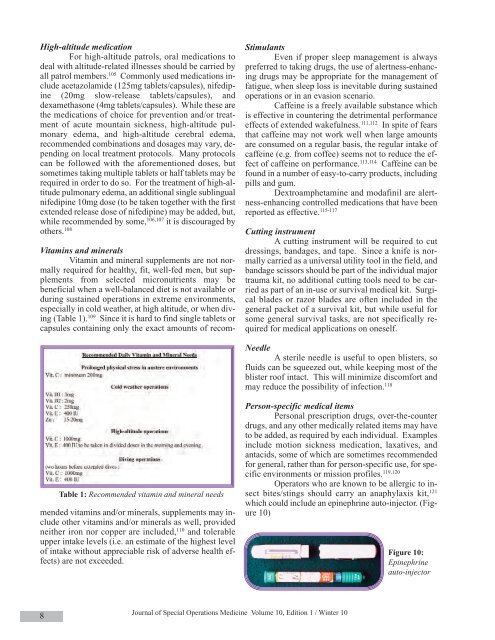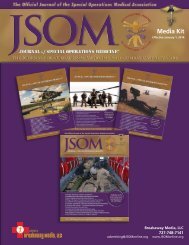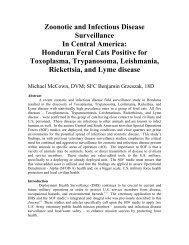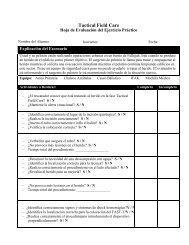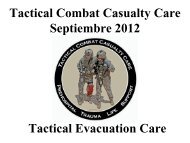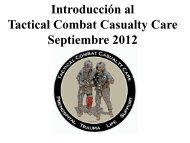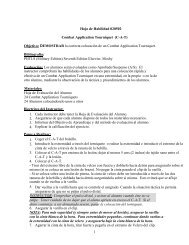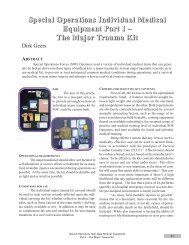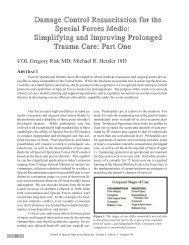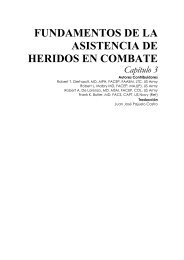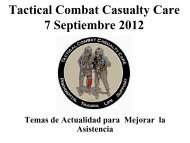Geers D. Special Operations Individual Medical Equipment Part 2
Geers D. Special Operations Individual Medical Equipment Part 2
Geers D. Special Operations Individual Medical Equipment Part 2
Create successful ePaper yourself
Turn your PDF publications into a flip-book with our unique Google optimized e-Paper software.
High-altitude medication<br />
For high-altitude patrols, oral medications to<br />
deal with altitude-related illnesses should be carried by<br />
all patrol members. 105 Commonly used medications include<br />
acetazolamide (125mg tablets/capsules), nifedipine<br />
(20mg slow-release tablets/capsules), and<br />
dexamethasone (4mg tablets/capsules). While these are<br />
the medications of choice for prevention and/or treatment<br />
of acute mountain sickness, high-altitude pulmonary<br />
edema, and high-altitude cerebral edema,<br />
recommended combinations and dosages may vary, depending<br />
on local treatment protocols. Many protocols<br />
can be followed with the aforementioned doses, but<br />
sometimes taking multiple tablets or half tablets may be<br />
required in order to do so. For the treatment of high-altitude<br />
pulmonary edema, an additional single sublingual<br />
nifedipine 10mg dose (to be taken together with the first<br />
extended release dose of nifedipine) may be added, but,<br />
while recommended by some, 106,107 it is discouraged by<br />
others. 108<br />
Stimulants<br />
Even if proper sleep management is always<br />
preferred to taking drugs, the use of alertness-enhancing<br />
drugs may be appropriate for the management of<br />
fatigue, when sleep loss is inevitable during sustained<br />
operations or in an evasion scenario.<br />
Caffeine is a freely available substance which<br />
is effective in countering the detrimental performance<br />
effects of extended wakefulness. 111,112 In spite of fears<br />
that caffeine may not work well when large amounts<br />
are consumed on a regular basis, the regular intake of<br />
caffeine (e.g. from coffee) seems not to reduce the effect<br />
of caffeine on performance. 113,114 Caffeine can be<br />
found in a number of easy-to-carry products, including<br />
pills and gum.<br />
Dextroamphetamine and modafinil are alertness-enhancing<br />
controlled medications that have been<br />
reported as effective. 115-117<br />
Cutting instrument<br />
A cutting instrument will be required to cut<br />
dressings, bandages, and tape. Since a knife is normally<br />
carried as a universal utility tool in the field, and<br />
bandage scissors should be part of the individual major<br />
trauma kit, no additional cutting tools need to be carried<br />
as part of an in-use or survival medical kit. Surgical<br />
blades or razor blades are often included in the<br />
general packet of a survival kit, but while useful for<br />
some general survival tasks, are not specifically required<br />
for medical applications on oneself.<br />
Needle<br />
A sterile needle is useful to open blisters, so<br />
fluids can be squeezed out, while keeping most of the<br />
blister roof intact. This will minimize discomfort and<br />
may reduce the possibility of infection. 118<br />
Table 1: Recommended vitamin and mineral needs<br />
Vitamins and minerals<br />
Vitamin and mineral supplements are not normally<br />
required for healthy, fit, well-fed men, but supplements<br />
from selected micronutrients may be<br />
beneficial when a well-balanced diet is not available or<br />
during sustained operations in extreme environments,<br />
especially in cold weather, at high altitude, or when diving<br />
(Table 1). 109 Since it is hard to find single tablets or<br />
capsules containing only the exact amounts of recommended<br />
vitamins and/or minerals, supplements may include<br />
other vitamins and/or minerals as well, provided<br />
neither iron nor copper are included, 110 and tolerable<br />
upper intake levels (i.e. an estimate of the highest level<br />
of intake without appreciable risk of adverse health effects)<br />
are not exceeded.<br />
Person-specific medical items<br />
Personal prescription drugs, over-the-counter<br />
drugs, and any other medically related items may have<br />
to be added, as required by each individual. Examples<br />
include motion sickness medication, laxatives, and<br />
antacids, some of which are sometimes recommended<br />
for general, rather than for person-specific use, for specific<br />
environments or mission profiles. 119,120<br />
Operators who are known to be allergic to insect<br />
bites/stings should carry an anaphylaxis kit, 121<br />
which could include an epinephrine auto-injector. (Figure<br />
10)<br />
Figure 10:<br />
Epinephrine<br />
auto-injector<br />
8<br />
Journal of <strong>Special</strong> <strong>Operations</strong> Medicine Volume 10, Edition 1 / Winter 10


